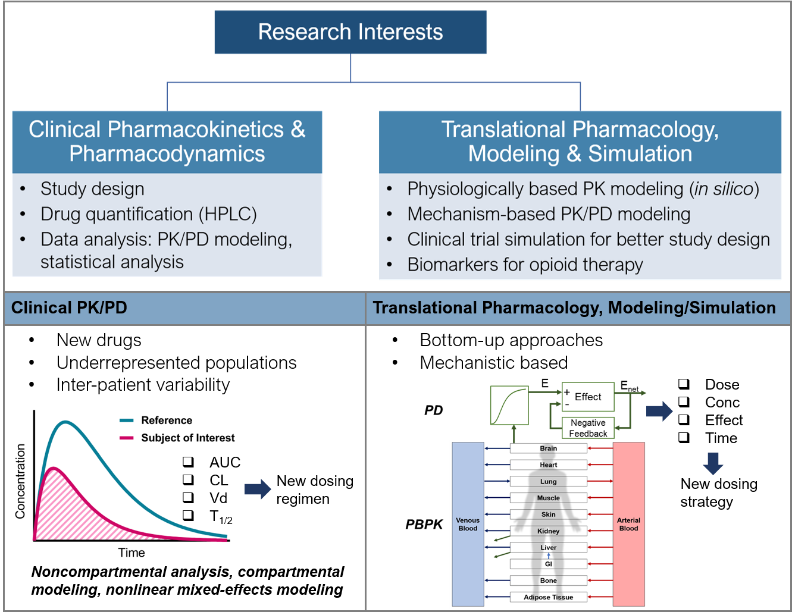- Mailing Address:
- School of Pharmacy
- University of Wisconsin
- 777 Highland Ave.
- Madison, WI 53705
- Office:
- 1033 Rennebohm Hall
- Phone: 608-263-6672 Email: sinyin.lim@wisc.edu
- Clinical Practice, Innovation, and Research Division
- Lim Research Group website

Sin Yin Lim, PharmD, MS
Assistant Professor (CHS)
Sin Yin's research utilizes quantitative pharmacokinetics and pharmacodynamics (PK/PD) modeling approach to improve pharmacotherapy. His research has emphasized on understanding and quantifying the impact of physiological changes and pathological factors on drug disposition in pediatric population. He has utilized mechanistically- and physiologically-based PK, and population PK/PD modeling and simulation approaches to describe drug disposition and to evaluate and individualize dosing strategies in children. Currently, his research is focused on optimizing pain and sedation management in critically ill children, by studying biomarkers and developing a PK/PD model that can help identify tolerance to opioid and sedative therapy, reduce exposure of children to opioids, and avoid iatrogenic withdrawal syndrome.

Sin Yin received his PharmD degree and a MS in Clinical and Translational Science from the University of Oklahoma Health Sciences Center (OUHSC). He also completed a pharmacy residency and a pediatric pharmacotherapy fellowship with OUHSC before joining the School of Pharmacy at UW-Madison.
PHARM 621 Pharmacokinetics
PHMSCI 756 Data Analyses in Drug Development
PHMSCI 768 Pharmacokinetics
- Lim SY, Cengiz P. Opioid tolerance and opioid-induced hyperalgesia: Is TrkB modulation a potential pharmacological solution? Neuropharmacology. 2022 Dec 1;220:109260.
- Lim SY, May C, Johnson P, Miller L. Caffeine dosing in premature neonates: impact of birth weight on a pharmacokinetic simulation study. Petriatr Res. Jun 2022. doi: 10.1038/s41390-022-02172-y. PMID: 35717480.
- Lim SY. Opioid effects on the central nervous system and the peripheral immune system: implications for opioid tolerance. Current Pharmacology Reports. 2021;7: 81–95. https://doi.org/10.1007/s40495-021-00258-5
- Lim SY, Miller JL, Henry E, Heltsley R, Woo S, Johnson PN. Analysis of Fentanyl Pharmacokinetics, and its Sedative Effects and Tolerance in Critically-Ill Children. Pharmacotherapy. Feb 2021. doi:10.1002/phar.2515.
- Lim SY, Miller JL. Ampicillin dose for early and late-onset Group B Streptococcal disease in neonates. Am J Perinatol. 2020 doi: 10.1055/s-0040-1718880.
- Lim SY*, Lewis TV*, Woo S, Bourne DWA, Burton ME, Turman MA, Rianthavorn P. Daptomycin pharmacokinetics in adolescents undergoing hemodialysis and peritoneal dialysis: a case series with pharmacokinetic modeling. *Equal contribution. J Pediatr Pharmacol Ther. 2021;26(2):123-132. doi: 10.5863/1551-6776-26.2.123
- Lim SY, Sharan S, Woo S. Model-based meta-analysis of cannabidiol dose-exposure relationship and bioavailability. Pharmacotherapy.2020;40(4):291-300 doi: 10.1002/phar.2377
- Lim SY, Woo S, Miller JL, Skrepnek G, Henry E, Johnson PN. Prediction and comparison of fentanyl infusion pharmacokinetics in obese and non-obese children. Pediatr Crit Care Med. 2019; 20(12):e556-e564. doi: 10.1097/PCC.0000000000002125
- Lim SY, Pettit R. Pharmacokinetic consideration in pediatric pharmacotherapy. Am J Health Syst Pharm. 2019; 76(19):1472-1480. doi: 10.1093/ajhp/zxz161
- Johnson PN, Stephen K, Barker P, Bergeron E, Lim SY, Hagemann T, Lewis T, Neely S, Miller JL. Prescribing patterns of continuous infusions in nonobese versus obese children admitted to the pediatric intensive care unit. J Pediatr Intensive Care. 2019;8(4):226-232.
- Lim SY, Woo S, Miller JL, Lewis TV, Henry E, Johnson PN. Dosing for fentanyl infusion in obese children: Just because it's what we have always done doesn't mean it is right. J Pediatr Pharmacol Ther. 2018;23(3):223-226.